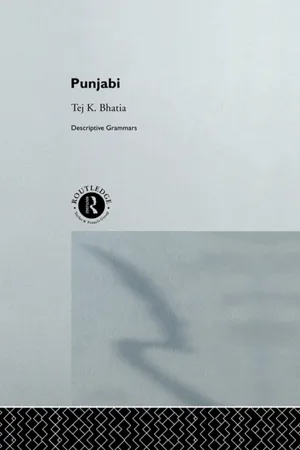![]()
MORPHOLOGY
2.1 INFLECTIONAL MORPHOLOGY
2.1.1 NOUN INFLECTION
2.1.1.1 Means used to express syntactic and semantic functions of noun phrases
The syntactic and semantic functions of noun phrases can be expressed by case suffixes, postpositions and derivational processes Word order plays a role only in the non-ergative construction where inanimate objects do not distinguish themselves from subjects in terms of case-marking.
Let us observe the paradigms of muNDaa ‘boy’ and kuRii ‘girl’ to examine the role of suffixes and postpositions to convey different cases.
(508)Unmarked masculine: muNDaa ‘boy’(ms)
| CASES | NOUN | POSTPOSITION |
| Direct | muNDaa | ∅ |
| Oblique | muNDe | ne(ergative) |
| | nüü (accusative/dative) |
| | tõ (instrumental) |
| | te (locative) |
| | daa/de/dii/diāā(genitive) |
| Vocative | õé/ve | muNDiaa | |
Marked masculine nouns:ending in non-aa, aadmii ‘man’
| CASES | NOUN | POSTPOSITION |
| Direct | aadmii | ∅ |
| Oblique | aadmii | ne (ergative) |
| | nüü (accusative/dative) |
| | tõ (instrumental) |
| | te (locative) |
| | daa/de/dii/diāā (genitive) |
Unmarked feminine: kuRii ‘girl’ (fs)
| CASES | NOUN | POSTPOSITION |
| Direct | kuRii | ∅ |
| Oblique | kuRii | ne (ergative) |
| | nüü (accusative/dative) |
| | tõ (instrumental) |
| | te (locative) |
| | daa/de/dii/dāā (genitive) |
Marked feminine nouns: ending in non-ii, raat ‘night’
| CASES | NOUN | POSTPOSITION |
| Direct | raat | ∅ |
| Dblique | raat | ne (ergative) |
| | nüü (accusative/dative) |
| | to (instrumental) |
| | te (locative) |
| | daa/de/dii/diāā (genitive) |
(The vocative markers--óé/ve and nii--precede a noun.) From the above paradigms, it is clear that bound suffixes such as word-final aa and e in muNDaa and muNDe ‘boy’, respectively mark case in Punjabi. Nouns are inflected for number, gender and case. There are two numbers--singular and plural; two genders--masculine and feminine; and three cases--simple, oblique, and vocative. Nouns are declined according to their gender class, and the phonological property of their final segments. The three main patterns of nominal declension in Majhi are as follows:
Pattern I: masculine nouns ending in -aa (like muNDaa ‘boy’, nakshaa ‘map’)
| CASE | SINGULAR | PLURAL |
| Direct | muNDaa ‘boy’ | muNDe |
| Oblique | muNDe | muNDiaa |
| Vocative | muNDiaa | muNDio |
| Direct | nakshaa ‘map’ | nakshe |
| Oblique | nakshe | nakshiāā |
| Vocative | nakshiaa | nakshio |
Pattern II: masculine nouns ending in non-aa (like aadmii ‘man’, kàr ‘house’, tòbii ‘washerman’, hatth ‘hand’)
| CASE | SINGULAR | PLURAL |
| Direct | aadmii ‘man’ | aadmii |
| Oblique | aadmii | aadmiiāā |
| Vocative | aadmiiaa | aadmiio |
| CASE | SINGULAR | PLURAL |
| Direct | kàr ‘house’ | kàr |
| Oblique | kàr | kàrā |
| Vocative | kàraa | kàro |
| Direct | tóbii ‘washerman’ | tòbii |
| Oblique | tòbii | tòbiiaa |
| Vocative | tòbiiaa | tdbiiāā |
| Direct | hatth ‘hand’ | hatth |
| Oblique | hatth | hatthaa |
| Vocative | hatthaa | hattho |
Pattern III: all feminine nouns (like kuRii ‘girl’, gāā ‘cow’, raat ‘night’)
| CASE | SINGULAR | PLURAL |
| Direct | kuRii ‘girl’ | kuRiiāā |
| Oblique | kuRii | kuRiiāā |
| Vocative | kuRie | kuRiio |
| Direct | raat ‘night’ | raatāā |
| Oblique | raat | raatā |
| Vocative | raate | raato |
Lahanda, Shahpur Doabi and Pothohari differ from Majhi and exhibit six instead of three patterns of nominal declension.
A list of case-suffixes is given below.
| (509) | CASE | SINGULAR | PLURAL |
| Direct | -aa/ø | -e/ø/āā |
| Oblique | -e/ø | iāā/āā |
| Vocative | -iaa/aa/e | -io/-o |
Case suffixes bring forth some morphophonemic changes in the stem of a noun. However, morphophonemic change alone cannot denote case relationship. (See section 3.4.1.3 for more on morphophonemic alternations.)
The semantic content of postpositions is essentially similar...
